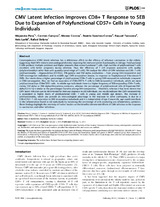Mostrar el registro sencillo del ítem
CMV Latent Infection Improves CD8+ T Response to SEB Due to Expansion of Polyfunctional CD57+ Cells in Young Individuals
| dc.contributor.author | Pera Rojas, Alejandra | |
| dc.contributor.author | Campos Fernández, Carmen | |
| dc.contributor.author | Sánchez-Correa, Beatriz | |
| dc.contributor.author | Tarazona, Raquel | |
| dc.contributor.author | Larbi, Anis | |
| dc.contributor.author | Solana Lara, Rafael | |
| dc.contributor.author | Alonso, Corona | |
| dc.date.accessioned | 2017-04-04T12:32:21Z | |
| dc.date.available | 2017-04-04T12:32:21Z | |
| dc.date.issued | 2014 | |
| dc.identifier.uri | http://hdl.handle.net/10396/14738 | |
| dc.description.abstract | Cytomegalovirus (CMV) latent infection has a deleterious effect on the efficacy of influenza vaccination in the elderly, suggesting that CMV restricts immunological diversity impairing the immune system functionality in old age. Polyfunctional T cells produce multiple cytokines and higher amounts than mono-functional T cells. High number of polyfunctional T cells correlates with better prognosis during infection. Thus, the efficiency of T cell response associates with quality (polyfunctionality) rather than with quantity (percentage of T cells). We analyze the effect of CMV infection on CD8+ T cells polyfunctionality ---degranulation (CD107a), IFN-gamma and TNF-alpha production---, from young CMV-seropositive and CMV-seronegative individuals and in middle age CMV-seropositive donors, in response to Staphylococcal Enterotoxin B mainly TNF-alpha or TNF-alpha/IFN-gamma producers, whereas the percentage of polyfunctional cells (IFN-gamma/TNFalpha/ CD107a) is similar to the percentages found in young CMV-seropositive. Therefore, whereas it has been shown that CMV latent infection can be detrimental for immune response in old individuals, our results indicate that CMV-seropositivity is associated to higher levels of polyfunctional CD8+ T cells in young and middle age donors. This increase in polyfunctionality, which can provide an immunological advantage in the response to other pathogens, is due to a CD8+CD57+ T cell expansion in CMV-seropositive individuals and it is independent of age. Conversely, age could contribute to the inflammation found in old individuals by increasing the percentage of cells producing pro-inflammatory cytokines. These findings highlight the necessity of further studies on the benefits/detrimental effects of CMV infection in the response to vaccination and other infections | es_ES |
| dc.format.mimetype | application/pdf | es_ES |
| dc.language.iso | eng | es_ES |
| dc.publisher | Public Library of Science | es_ES |
| dc.rights | https://creativecommons.org/licenses/by-nc-nd/4.0/ | es_ES |
| dc.source | PLoS ONE 9 (2): e88538 (2014) | es_ES |
| dc.subject | Cytomegalovirus | es_ES |
| dc.subject | CMV | es_ES |
| dc.subject | Inmunology | es_ES |
| dc.title | CMV Latent Infection Improves CD8+ T Response to SEB Due to Expansion of Polyfunctional CD57+ Cells in Young Individuals | es_ES |
| dc.type | info:eu-repo/semantics/article | es_ES |
| dc.relation.publisherversion | http://dx.doi.org/10.1371/journal.pone.0088538 | es_ES |
| dc.relation.projectID | Gobierno de España. FIS Ref PS09/00723 | es_ES |
| dc.relation.projectID | Gobierno de España. SAF2009-09711 | es_ES |
| dc.rights.accessRights | info:eu-repo/semantics/openAccess | es_ES |

